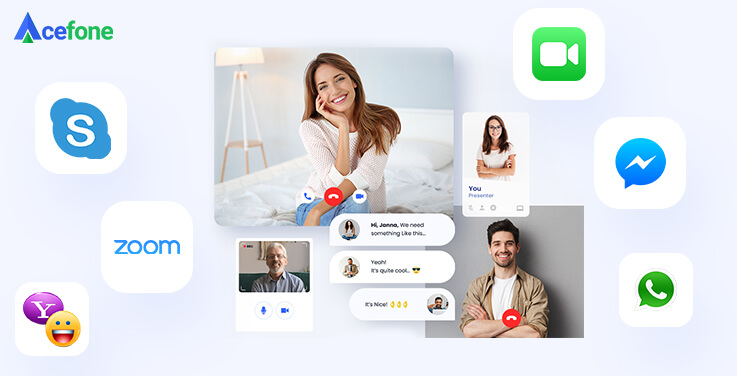Let’s start off by admitting that many of us have been pulled into late night meetings while working from home. Thanks to COVID-19, late-night meetings and sudden calls became a part of our routine.
Zoom, Google Meet, Microsoft Teams, Cisco Webex, and even WhatsApp are some of the platforms that allow such meetings to take place. One moment you’re having dinner, and in the next you’re attending a video conference with your team, in your bedroom.
Do you ever think where it all began?
The birth of video conferencing can be traced back to the late 1800s, when Bell’s invention, the telephone, revolutionized communication. Even before the advent of the telephone, visionaries had conceived the idea of transmitting images over long distances.
In 1876, the concept of videotelephony was already being discussed. These early discussions laid the groundwork for what would eventually become the cornerstone of modern video conferencing.
Let’s look at the evolution of video calling apps in this brief timeline.
Where it all started
Two years after the invention of the telephone, the Bell Labs came up with an idea for a combination of a videophone and wide-screen television, naming it “telephonoscope.”
Although it took some time to achieve this successfully, video conferencing and video calling apps became increasingly popular and now stand as a pillar of modern relationships.
Here is a timeline that shows how various large companies started their video calling services or when they incorporated them into their platform:
1970s-1990s: The era of emerging videophones
AT&T’s second picturephone model, Mod II was inaugurated in June of 1970. This was the first time that people did not need to visit special booths to make calls but could ask for a connection right from their homes and offices.
AT&T’s Mod II
Source: Labguy, a.k.a. Richard Diehl, CC BY 3.0
This service flopped soon though. People weren’t yet accustomed to being observed on the phone. They also found the service too costly for regular use.
Through the 1980s and 1990s, Compression Labs (AT&T’s competitor) launched its corporate video conferencing system in 1982 while 1988 saw Japan’s foray into the industry with Mitsubishi’s videophone.
More and more companies found themselves stepping into the video conferencing world. However, these initial video calling systems were incredibly expensive and mostly designed for use by large corporations. Corporate Labs’ product cost a staggering $250,000, rendering it unfeasible for the public.
1996: Webex Meetings

Launched in 1996 by Subrah Iyar and Min Zhu, Webex Meeting Center pioneered the concept of online meetings. It allowed users to collaborate and communicate in real-time over the internet.
After being acquired by Cisco in 2007, Webex was revamped and launched as the Cisco Webex Meetings in 2010. In response to the technological advancements, the Cisco Webex Meeting Center continued to evolve. It introduced new features such as HD video conferencing, mobile compatibility, and integration with other productivity tools.
By 2024, Webex has gone through several rebranding, technical advancements, with new features such as Webex Personal Room and Webex Assistant.
1999: Yahoo! Messenger
With the launch of the webcam in the 1990s, things started to change, and we slowly entered the era of rampant video calling apps—the end of the millennium.
Yahoo! Pager, launched in the year 1998, was renamed as Yahoo! Messenger in 1999 and served as an instant messaging app for everyone. You could make VoIP (Voice over Internet Protocol) calls, join chat rooms, transfer files, and host video calls over webcams.
The early 2000s saw this video calling app making waves as it connected people over slow Internet cables and brought them face-to-face. Since Yahoo! Mail was also extremely popular, companies allowed users to have a unified Yahoo ID, serving multiple needs.
2005: Skype

Founded in 2003, and sole to eBay in 2005, Skype became one of the most popular VoIP and video calling apps worldwide. Skype’s user-friendly interface, affordable pricing, and cross-platform compatibility made it a favourite among consumers and businesses alike.
It was acquired by Microsoft in 2011 and has been developing constantly under the tech giant since then. By 2013, Skype released its free video messaging service for all major operating systems.
Today, this video calling app is supported on a variety of devices—from smartphones, computers and tablets to even Xbox consoles and smartwatches.
Around 2016-17, Skype transitioned from its peer-to-peer system to Microsoft Azure’s cloud computing system. The constant improvements in devices and Internet connectivity make the app and the video conferencing industry thrive more.
2010: Facetime
Chabe01, CC BY-SA 4.0, via Wikimedia Commons
As Apple Inc. gained more and more traction, founder Steve Jobs announced the release of Facetime, a videotelephony software exclusively for Apple users, in 2010. At first, it only allowed one-on-one calling, meaning new calls required you to cut off the previous one.
Its high-definition video calling capabilities made it a fan favourite regardless of this limitation. In 2018, with the iOS 12.1 update, Facetime introduced video calling—and how! You could now practice video conferencing with up to 32 people at the same time!
Additionally, the ease-of-use and integration with other Apple software like iMessage, made Facetime one of the most popular services available. Besides, you can access Facetime on Apple’s non-telephony devices like the iPad, iPod Touch and Mac and always stay connected with your friends and family.
2011: Zoom

Who hasn’t heard of Zoom? This video calling app has become rather synonymous with online meetings and remote work.
Launched in 2011 as a videotelephony service, Zoom launched a beta version for video conferencing with 15 participants within a year. By 2013, Zoom reported 1 million users, showing early signs of the great success that was to follow.
Over time, the company integrated with famous third-party apps like Slack and Salesforce. By 2015, it expanded its participant limit to 50 people, enabling large-scale video conferencing.
This ability proved especially useful during the global pandemic in 2020 as people realised the importance of video conferencing for work meetings. The education industry, particularly, relied heavily on Zoom to accommodate numerous students for online lectures over video conferencing. Zoom even offered its services for free to K-12 schools in quite a few countries.
2015: Facebook Messenger
Started as a messaging app for the huge Facebook user base, Facebook Messenger stepped into the voice call arena in 2013. By 2015, it was offering video calling services, and a year later, group voice calls for up to 50 participants were introduced. They also tried to rope in the younger generation by introducing live filters and emojis during video calls.
What was primarily a social app for casual conversations, tested the corporate waters in 2015 by allowing business interactions between customers and companies.
In 2020, to compete with Zoom’s massive popularity, Facebook introduced Messenger Rooms. You could create rooms, public, exclusive or on link-based entry. While in Messenger video calls, you could view one main speaker and 6 participants at a time on screen. The new video calling app allows better viewing for larger parties.
2016: Whatsapp

Undeniably one of the most popular messaging and VoIP calling apps in the world, Whatsapp started way back in 2009 when the founders realised the potential for the App market.
It didn’t take too long for the app to gain favour as it continued to tweak its features on the go. By 2011, Whatsapp was part of the top 20 apps on Apple’s American App Store.
When Facebook Inc. acquired Whatsapp in 2014, the world was left agog at the mammoth purchase (on the lines of $19 billion). And just a year later, the company entered the voice call market, and by 2016, video calling was incorporated as well.
By now, the app was already being widely used for all kinds of calls, but 2018 proved to be a big year. Apart from creating a Whatsapp platform for businesses, they also introduced group voice and video calls for up to 8 people at a time, making conferencing feasible and super convenient.
In the latest news, it is expected that voice and video calls will be added to the desktop version, Whatsapp Web, in addition to the mobile app. This version is apparently in its beta testing stage, which means it won’t be long till it’s officially released, and you’ll be able to make Whatsapp calls directly from your computer!
2016: Google Duo and Google Meet

Google, CC BY-SA 4.0, via Wikimedia Commons
Google launched its video calling app in 2016—Google Duo, to replace Hangouts. With HD video calling even in low bandwidth, end-to-end encryption and high brand accessibility, it proved to be quite a successful venture.
In the year 2020, Google Meet was launched as a more robust and enterprise-focused solution while maintaining Google Duo for consumer-oriented video calling. Coincidently, it aligned with the growing demand for remote collaboration tools during the COVID-19 pandemic and experienced a boom in its demand among businesses.
2017: Microsoft Teams

With the addition of features like audio calls and screen sharing, Teams expanded its capabilities, catering to diverse collaboration needs. Microsoft solidified Teams’ infrastructure to meet regulatory requirements and ensure user data protection.
The platform’s adaptability shone during the COVID-19 pandemic, prompting the introduction of remote-friendly features like virtual backgrounds and breakout rooms. With the ongoing updates and improvements, Microsoft Teams continues to redefine workplace collaboration. It offers a dynamic and versatile video conferencing platform for teams worldwide.
Conclusion
What started as a revolutionary vision, unsupported by the science of the time, has today become commonplace and rather a way of life.
Videotelephony and video conferencing have gained so much traction because of one primary reason: the fast-paced lives we lead today.
Therefore, the ability to come face-to-face with people allows more balanced and clear communications. We can now talk with our expressions and body language effectively.
What do you think of the journey of video conferencing? How has your experience been with these famous video calling apps, share your thoughts with us in the comments down below!
To learn more about cloud-based communications and their potential for your business, don’t hesitate to reach out to us at [email protected] or call us at 1800-120-3100.


















